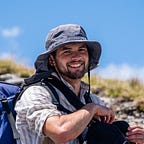The Karapoti giant
Karapoti Rātā, Akatarawa Forest
Deep in the Akatarawa hides a giant of the old world. Over a thousand years ago the seed of a northern rātā sprouted in the canopy of another tree. In the time since it slowly consumed its host, growing into a gnarled monolith of a time long past. Fast forward to the present day and my friend Sofia wanted to go for a day walk. I knew just the spot.
Our first mistake was not stopping for coffee on the way to Karapoti Road, this would come to haunt one of us later. The car park was empty when we arrived, bar the sheep staring at us over the fence. We set off down the old Karapoti Road. Not far down the road we reached a steel post and reflective marker that signaled the beginning of the old tramway up toward Mt Barton. Pushing through the trees I discovered the wide benched track. Sofia looked at the ‘track’ and then looked me with that “is that actually the track you expect me to follow” look.
Once other sources of easily accessible wood had been exhausted in the region the loggers axe began looking further afield. Logging in the Akatarawa in the early 20th century, primarily targeting easy to mill rimu, matai, totara, kahikatea. An extensive network of infrastructure was built to support the enterprise including tramways with wooden rails for hauling out timber and mills deep in the forest. Rātā escaped the wrath of the sawyer, its gnarled and hardened trunks undesirable compared to the other trees of the forest.
Any reluctance Sofia had to following this track melted away with the company of a friendly pīwakawaka. The tramway climbed slowly before crossing a branch of the Little Akatarawa. Here I had to apologise to Sofia because I had failed to mention one little 3 metre cliff that we would have to negotiate using an old rope to reach our objective…
It took a packet of sour squirms to coerce Sofia past her fear of heights and over the edge. A few squirms later and we were back on our way. Soon we met the Little Akatarawa River. Here the benched tramway faded away, leaving us to follow the lazy waters to their headwaters. Sofia was intent on keeping her feet dry, many amusing situations. Ferns clad the banks of the river as it twisted in and out of a gorge.
We wove from bank to bank, skipping easily along. I didn’t even need to get my feet soggy. The river provided good going, everything was going great (other than Sofia complaining about the odd headache). Rather than follow the river toward Mt Barton we followed spray-painted dots to the north. This led us back onto a benched tramway which we followed for a short way before turning off the beaten track. We climbed through the undergrowth guided by a few bits of tape and a sense of adventure. A Good Nature stoat trap signaled that we were close to our destination, but where was it? We turned down a sidetrack and wandered some way before wondering if we were headed in the right direction. Hopping over a log we stopped for a snack, lest Sofia got hangry…
I reexamined my route notes and realised that the traps we had seen must have been very close to the tree, rather than the sidetrack we were on. Retracing our steps we soon found the traps. Next door was a sizable, yet not abnormally impressive, rātā. I wondered if I’d just been over-exposed to massive rātā. Then I saw it. Just down the trail. A wall of wood emerging from the undergrowth.
We lay on the ground to stare up at the canopy and ponder life. The tree stretched over 38 metres into the air and measured 15 metres around. When we got up to go Sofia expressed that she did not feel good. She did not look good either. I could do nothing but offer her a sour squirm and some words of encouragement. On the plus side, this sudden bout of mystery sickness had given her the superpower of not-giving-a-damn about anything. Instead of tip-toeing through the many stream crossings she blitzed through at terrifying pace. There was one obstacle that nearly proved too much. Boss woman as she was (and is), the rock-climbing wall proved to be an emotional moment. So emotional in fact that I decided that it would be bad taste to be taking photos. Instead, I channeled every ounce of encouragement that I had and the last of the sour squirms to get Sofia to the top. But she did! From here it didn’t take long until we emerged from the bush, stumbling back onto Karapoti Road.
[Karapoti Rātā, 3–4 hours return]
The colossus we lay beside was over a thousand years old. It was there when Māori first landed in Aotearoa. It was there when moa roamed freely around the forests of the North Island. It creaked and groaned as pākehā arrived, bringing with them pests like possums that would destroy its crown. But somehow it survived, and now with a bit of help it flourishes again. Suddenly my 26 years of life and all my worldy problems seem insignificant in comparison.
Epilogue
The Sofia problem was not insignificant though. Once we got to the car there were no more sour squirms and she quickly deteriorated. We made an urgent detour to get aspirin on our way home. Three minutes after I dropped her off she power-vomited spectaculary in her car. You will be pleased to hear that she has since made a complete recovery. Later diagnosed as caffeine withdrawals (and maybe food poisoning). Should have stopped for that morning coffee after all.
